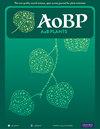Survival analysis of freezing stress in the North American native perennial flax, Linum lewisii Pursh
IF 2.4
3区 生物学
Q2 ECOLOGY
引用次数: 0
Abstract
The expansive range of Lewis flax (Linum lewisii Pursh.), an herbaceous perennial, exposes the species to a diversity of climatic conditions. As interest in the domestication and adoption of perennial crop alternatives grows and interest in this species for natural area restoration continues, the assurance of a commercial plant variety’s ability to endure the full range of possible climatic extremes is paramount. This study examines the freezing tolerance of a geographically representative sampling of 44 Lewis flax accessions at winter temperature extremes experienced in the northern Great Plains of the United States. Survival analysis models were adapted to include temperature exposure, in replacement of ordinal time typically used in such models, to produce statistics evaluating reactions to extreme temperatures that Lewis flax would encounter in our field environments. Our results revealed Lewis flax is more freezing tolerant than previously reported, and revealed four accessions with significantly superior genetic freezing tolerance than the released ‘Maple Grove’ cultivar. Furthermore, regrowth analyses indicate variation among accessions not associated with survival, which could lead to improving regrowth rate and survival simultaneously. These findings and their methodology expand the understanding of Lewis flax adaptation for winter hardiness and offer an efficient, new model that can be used to evaluate freezing tolerance at ordinal temperatures without requiring extensive prior physiological knowledge for a species.北美本地多年生亚麻 Linum lewisii Pursh 受冷冻胁迫的存活率分析
多年生草本植物刘易斯亚麻(Linum lewisii Pursh.)随着人们对驯化和采用多年生作物替代品的兴趣与日俱增,以及对该物种用于自然区域恢复的兴趣持续高涨,确保商业植物品种能够承受各种可能的极端气候条件至关重要。本研究考察了具有地理代表性的 44 个刘易斯亚麻品种在美国北部大平原冬季极端温度下的耐冻能力。对生存分析模型进行了调整,将温度暴露纳入其中,以取代此类模型中通常使用的序时,从而得出评估刘易斯亚麻在野外环境中遇到极端温度时的反应的统计数据。我们的研究结果表明,刘易斯亚麻比以前报道的更耐寒,并发现有四个品种的遗传耐寒性明显优于已发布的 "枫树林 "栽培品种。此外,重新生长分析表明,品种间的差异与存活率无关,这可以同时提高重新生长率和存活率。这些发现及其方法拓展了人们对路易斯亚麻适应冬季耐寒性的认识,并提供了一个高效的新模型,可用于评估在序数温度下的耐寒性,而不需要事先对一个物种有广泛的生理知识。
本文章由计算机程序翻译,如有差异,请以英文原文为准。
求助全文
约1分钟内获得全文
求助全文
来源期刊

AoB Plants
PLANT SCIENCES-
CiteScore
4.80
自引率
0.00%
发文量
54
审稿时长
20 weeks
期刊介绍:
AoB PLANTS is an open-access, online journal that has been publishing peer-reviewed articles since 2010, with an emphasis on all aspects of environmental and evolutionary plant biology. Published by Oxford University Press, this journal is dedicated to rapid publication of research articles, reviews, commentaries and short communications. The taxonomic scope of the journal spans the full gamut of vascular and non-vascular plants, as well as other taxa that impact these organisms. AoB PLANTS provides a fast-track pathway for publishing high-quality research in an open-access environment, where papers are available online to anyone, anywhere free of charge.
 求助内容:
求助内容: 应助结果提醒方式:
应助结果提醒方式:


